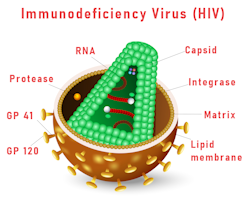Human Immunodeficiency Virus (HIV)
The Human Immunodeficiency Virus attacks and suppresses the immune system, reducing a person's ability to fight infection.

The virus specifically targets T cells that are crucial for fighting infection from pathogens. This allows diseases and infections to progress without resistance.
The transmission of bloodborne pathogens from one person to another occurs through the transfer of infected body fluids. Common body fluids which can transmit HIV pathogens include:
- blood,
- spinal fluid,
- semen,
- breast milk, and
- vaginal fluids
Semen and vaginal secretions can transmit bloodborne pathogens, but only during sexual contact. Wearing disposable gloves can help protect you from accidental exposure to bloodborne pathogens.
Within a few weeks of being infected with HIV, some people develop flu-like symptoms that last for a week or two, but others have no symptoms at all. People living with HIV may appear and feel healthy for several years. However, even if they feel healthy, HIV is still affecting their bodies.
Untreated early, ongoing HIV infection is also associated with many diseases including cardiovascular disease, kidney disease, liver disease, and cancer.
It can take many years before an HIV-infected person displays symptoms of the disease.
Symptoms include:
- enlarged lymph nodes
- fatigue
- frequent fevers
- persistent or frequent yeast infections of the mouth or vagina
- persistent or frequent skin rashes
- short-term memory loss
- weight loss
- enlarged liver and spleen
As with Hepatitis B virus and Hepatitis C virus, individuals with HIV are potentially infectious to others, even though they may have no observable symptoms.
HIV cannot reproduce outside the human body. It is not spread by:
- air or water
- insects, including mosquitoes Studies conducted by CDC researchers and others have shown no evidence of HIV transmission from insects.
- saliva, tears, or sweat (there is no documented case of HIV being transmitted by spitting.)
- casual contact like shaking hands or sharing dishes
- closed-mouth or "social" kissing
Knowledge Check Choose the best answer for the question.
1-5. Although HIV is a weak virus, why is it so dangerous?
You forgot to answer the question!
